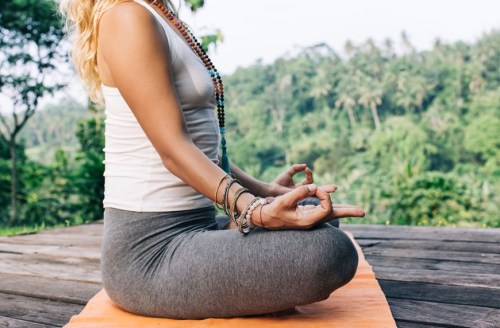First things first, for those who have never heard of hand mudras: They’re not complicated, and you can start incorporating them into your life stat to reap the well-being benefits. To put it simply, mudras are hand positions that are used during meditation to “reinforce specific healing states of mind,” says meditation teacher and transformational coach Sah D’Simone. They help “draw your mindfulness inward and reconnect you with your heart’s language of compassion, kindness, goodness, creativity, and joy,” he says. Sounds beautiful, right?
“Mudras draw your mindfulness inward and reconnect you with your heart’s language of compassion, kindness, goodness, creativity, and joy.” —meditation teacher Sah D’Simone
Each finger represents a different element, Unplug Meditation teacher Megan Monahan says. The thumb symbolizes space; the index is air; the middle finger is fire; the ring finger is water; and the pinky stands for earth. So it is believed that by creating different mudras with your hands via different configurations of your fingers, you are tapping into that powerful energy. “You have within you the infinite organizing power of the universe,” Monahan says. “No big deal.”
Whether you’re a meditation newbie or use the Headspace app every single day, try out the following mudras whenever you feel like leveling up.
Read on to learn 9 hand mudras, their benefits, and how to do them.

1. Varada mudra
Meaning: Granting of wishes
Benefits: “Varada mudra evokes generosity, charity, giving, compassion, being part of the solution, and adding to human salvation,” D’Simone says. Do this mudra whenever you feel like spreading some good vibes and kindness.
How to do it: Create the mudra by resting your left hand on your left knee with the palm facing up and the fingers extended. You can make a different mudra with your right hand or just place it facing up on your lap, thigh, or knee.
2. Samadhi mudra
Meaning: Complete state of concentration
Benefits: The samadhi mudra, also known as the dhyana mudra, is the one you’ll often see the Buddha doing. “It supports deep concentration and clear focus,” D’Simone says. So if your attention is getting pulled in a million different directions and you’re multitasking but still not getting anything done, this one’s your go-to.
How to do it: Rest both hands on your lap with your palms facing up and your right hand on top of your left hand. Lightly touch the tips of your thumbs together.
3. Karana mudra
Meaning: Warding off evil
Benefits: “When negative feelings and thoughts have become sticky, and you’re not able to shake them off, try this mudra for a boost of happiness,” D’Simone says. “For me, there is an almost immediate upgrade in my internal landscape—calm, clarity, and simplicity.”
How to do it: Touch the middle and ring fingers of your right hand with your thumb and extend your index finger and pinky. (It kind of looks like a “rock on” hand signal.) Then bring your hand up right in front of your heart with your palm facing out. Meanwhile, your left hand can hang out on your lap facing up.
4. Jnana mudra
Meaning: Knowledge
Benefits: “If you have a meeting or presentation coming for which you need to memorize something, or you have a creative block, this is your mudra,” D’Simone says. “It’s also a simple and powerful way to remember that you have access to an inner fountain of wisdom right here within you.”
How to do it: Curl your index fingers toward the base of your thumbs to create a circle. The rest of your fingers remain straight out. Then rest your palms facing up or down on your knees.
5. Varuna mudra
Meaning: Balance water element in the body
Benefits: “This mudra can be of help to relieve constipation or indigestion,” D’Simone says. “But remember to also take your daily probiotic supplement, drink plenty of water, eat mostly a healthy, plant-based diet, and get good rest.” In other words, see the mudra as a little digestive boost rather than a cure-all.
How to do it: Touch the tip of your thumbs with the tip of your pinkies keeping your other three fingers extended out. Then place your hands facing up on your knees.
6. Gyan mudra
Meaning: Enhancing consciousness
Benefits: The gyan mudra is probably one you’ve seen a million times before—like in every. single. image. of someone meditating in mainstream media. But, just because it’s basic, that doesn’t mean you should disregard it, Monahan says. It’s intended to help you focus and enhance your consciousness and awareness.
How to do it: Simply touch the tip of your index finger with the tip of your thumb keeping your other three fingers straight out.
7. Prana mudra
Meaning: Vital life force
Benefits: “The prana mudra opens up channels of energy,” Monahan says. “This mudra is a great addition to your morning espresso to get any dormant energy moving.”
How to do it: Touch the tip of your thumb to the tips of your ring and little finger.
8. Apana mudra
Meaning: Eliminating toxins
Benefits: “The apana mudra helps regulate the energy in your lower abdomen, which governs outward flow of energy in the body,” Monahan says. “It can help with physical or even emotional digestion by helping to eliminate unnecessary elements from the body.”
How to do it: Similar to the karana mudra, touch the tip of your thumb to the tips of your middle and ring fingers while leaving your other two fingers extended. Then rest your hands facing up on your knees.
9. Shuni mudra
Meaning: Improving intuition
Benefits: “If you are looking for clarity and insight into your next steps and how to execute them effectively, this mudra is for you,” Monahan says. “The shuni mudra uses that fire within you to bring in that focused attention and intention.”
How to do it: Press the tip of your thumb with the tip of your middle finger.
Sign Up for Our Daily Newsletter
Get all the latest in wellness, trends, food, fitness, beauty, and more delivered right to your inbox.
Got it, you've been added to our email list.










